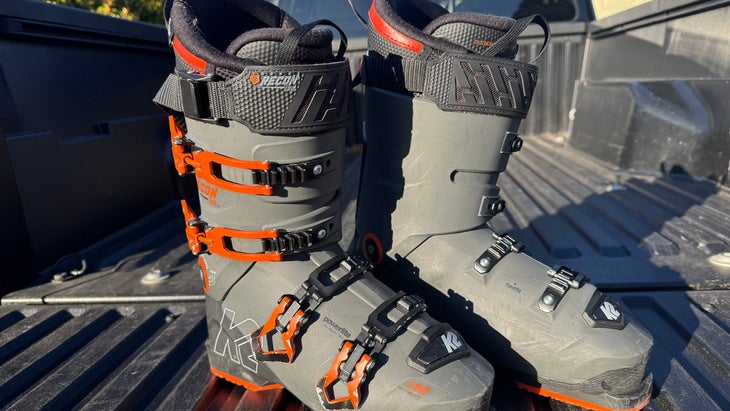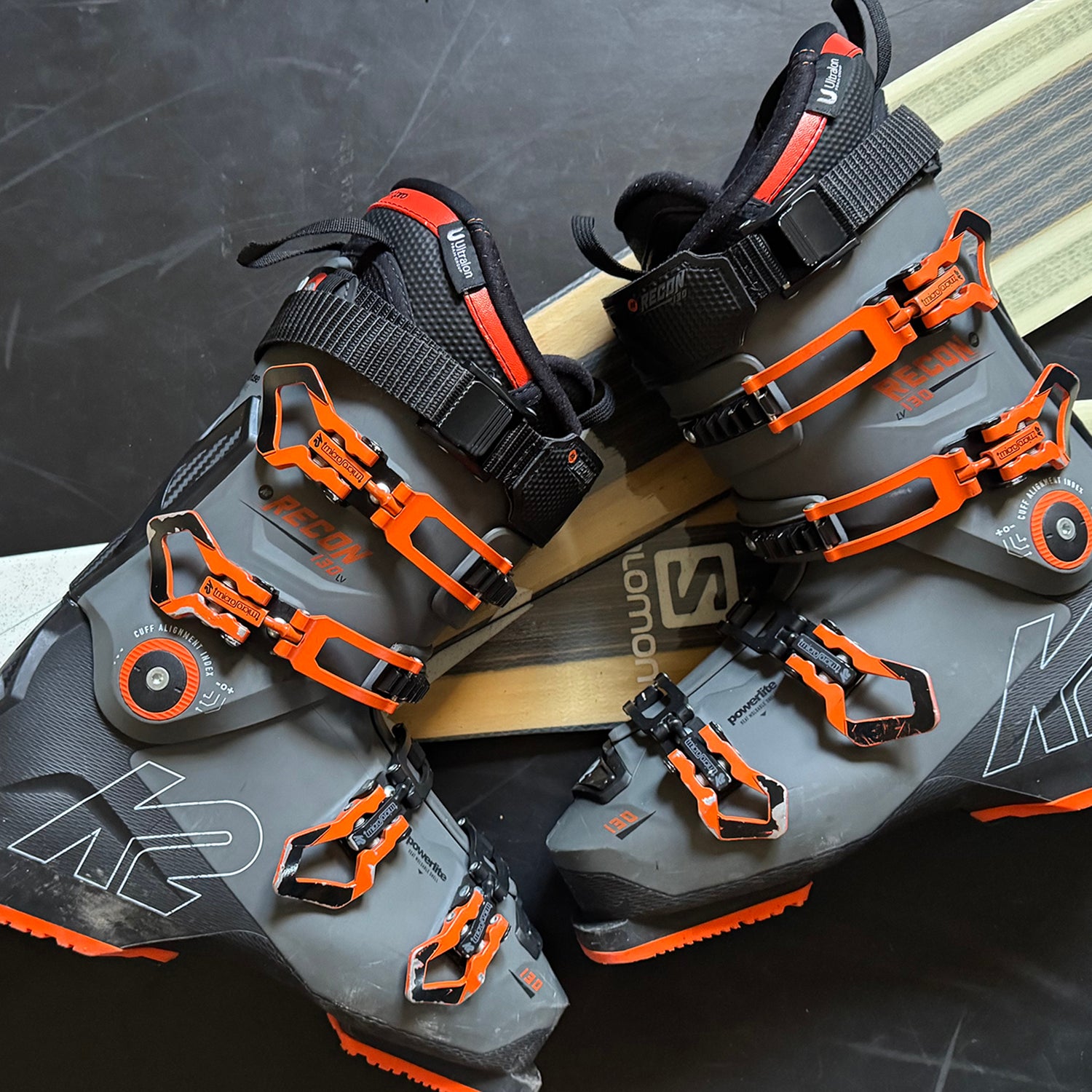I have a confession to make: I am super intimidated by ski boots. I have written about ski boots many times in the past decade and interviewed more than a dozen experts; I’ve skied hundreds of days in that time frame and worked as a professional ski instructor; and I still have a ton to learn about this complicated product. Without doubt, ski boots are the most challenging piece to buy in a ski kit. They also happen to be the most important when it comes to improving your performance and enjoyment on the hill.
I lucked into a pair of K2 Recon boots that worked for me in 2018, and am still using them out of fear of messing with the esoteric magic spell that delivers comfort to my misshapen feet.
Because I know I’m not the only one overwhelmed by the idea of finding new boots, I interviewed four experts to get to the bottom of what the everyday skier needs to know when shopping for ski boots. I ended up compiling 63 pages of notes and transcripts to try and demystify this piece of gear. Here’s your cheat sheet.
Related:
The Experts
The Bootfitters’ Bootfitter
Sam McDonald has been fitting boots for over a quarter of a century and his ability to distill down the nuances of the ideal fit for different feet, skiers, and body types is incredible. He has been working for Surefoot since 1997 and has been the manager of since 2010.
The Boot Tester
My friend Kelly Bastone has been my go-to personal resource for boot questions for years. She’s been a gear tester for ���ϳԹ���, Backpacker, and SKI for around a decade and has tested over 200 pairs of ski boots.
The Lifer
is a lifelong skier, writer, ski company marketing pro, and backcountry ski guide with deep roots in the ski industry. He’s the friend I turn to for ski gear advice because he knows a lot and tells it like it is.
The Boot Designer
is the lead ski boot engineer for K2 and a professional ski instructor. I challenge you to find someone who spends more time in or around ski boots.
4 Tips for Finding the Right Ski Boot

Flex is Tricky
The refers to how stiff the boot is and how much force it takes to get the cuff of the boot to flex forward. A higher flex number means a stiffer boot. Generally speaking, the stiffer the boot, the more a skier can crank on the skis to initiate a turn,��making stiff boots best suited to expert skiers. Flex numbers for adult ski boots range from 80 to 130, with 80 considered soft and anything above 115 considered stiff.
Ready for a myth I am excited to bust? Stronger skiers don’t��necessarily need a stiffer boot.
“Get over this whole idea of, I’m an expert skier, I should be in a 130 boot,” Bastone advised. “If you ski moguls, if you’re jumpy, if you like lots of air and lots of little landings and things, you might want to go down a little in flex because as soon as you hit something unexpected, you’re going to feel like the rodeo horse just bucked you really hard in that boot.”
Just because a stiffer boot is more expensive doesn’t mean it’s the best performing boot, Burrow added. “Typically, the stiffer the boot, the less comfort it provides.” Even though Burrow is an excellent skier, ski instructor, and has made a career designing boots, she doesn’t always prefer the stiffest option. “I’m in my boots all day and I’m also pretty small, so having a super stiff boot for me can be really challenging.”
Rather than blindly looking at a flex number, test out the flex for your body type and weight when you try boots on. “Once you put it on, do some forward flexes into it, and if you feel like you’re almost falling forward, then that boot’s probably going to be a little bit too soft,” said Burrow.
Flex is relative from boot company to boot company, so one brand’s��130 does not equal another’s. The first time I found that out, it made my head spin. If flex is causing you a similar level of stress, it is a good idea to go to a reputable shop to talk it out with an expert. “Flex and stiffness is hard because the numbers can be quite confusing. Going to see somebody that you trust or that your peers trust is super important,” McDonald said.
Good Fit Starts with Awareness
The best place to start is by looking down at your own feet and trying to gauge your (i.e. your food width and instep height). While a bootfitter can measure the contours of your foot to the millimeter, starting with a general idea of your foot volume and shape is going to narrow your search significantly.
These days, most boots come in three different volume options: high volume (HV in the model name), mid volume (MV), and low volume (LV). “Determining where you fall in that category can be really helpful when you’re looking at a wide range of boots, just to narrow down your selection,” Burrow said.
Trust yourself, here. “Most people know if they have a wide foot, a high arch, or narrow foot. I mean, they’ve been wearing shoes all their life,” Bastone said. Burrow agreed. “Foot volume can be determined by a bootfitter or if you just know yourself,” she said. If you’ve experienced instep pain in shoes or boots, that could indicate that you have a high-volume foot; if your foot is really narrow, chances are you belong in a low-volume��boot. “So just thinking about problems that you’ve had in everyday shoes, things like that and how you want your boot to fit is really important,” Burrow said.
Starting with the right volume is a non-negotiable for Bastone.“With my tester team, I was always really careful to match up the self estimated foot volume with the foot volume that the boot promises to fit,” Bastone said. “It’s awesome that even the stiff, high performance boots are often now made in a higher volume option. So it doesn’t have to be just the skinny-footed people that get the really great ski boots.”
You Can Have Comfort AND Performance
Another myth I’m stoked to bust: Ski boots are supposed to hurt if you want great performance. That’s simply no longer the case in 2024. “It’s totally possible to get ,” Bastone said.
While the line between tight and too tight might feel like a tough one to toe, Bastone has a killer analogy she received from a bootfitter years ago that she has held on to. “A great ski boot should feel like a friend’s handshake—even, warm, and supportive, but not aggressive,” she said.
It is worth noting that boots that feel comfortable in the ski shop or your living room might not always provide the same comfort on a full day of skiing. “Ski boots are not crocs. Going for something too comfortable means you’re going to have something that’s a little too big,” Hunt said. “A boot might feel great when you’re standing in the shop or sitting in the lodge. But once you start moving, it’s too loose and your feet start rubbing.Then you’ve got blisters.”
Aftermarket Insoles and Liners Are Worth It
Hunt offered some blunt advice when it comes to a ski boot’s stock components: “The stock insoles that come in ski boots just need to be tossed immediately,” he said.
“The two things that custom insoles do is make skiing easier and more comfortable,” McDonald added. He mentioned that the key to extended comfort in a boot is proper foot positioning. “The only way to effectively change your foot position is with a good custom insole. Ski boots are designed around a foot that’s in a certain position and you have to make sure you get an insole that holds you in that position.”
If you are looking for an extra layer of personalized comfort, investing in aftermarket liners ( and ��are some of the most popular options) that can be easily molded to your foot and ankle shape is a good idea.
Custom footbeds and liners are pricey and might deliver sticker shock if you are already dropping hundreds of dollars on boots, but McDonald maintained that his customers are always happy they made the purchase. “Breaking in a stock liner, even the highest quality, overly engineered liner that comes from the manufacturer, can take up to 30 days,” he said. “If you are willing to invest $10,000 a week in skiing at Whistler, or Aspen, or Vail, invest in some form of custom liner. It makes things way better and way easier for sure.”


